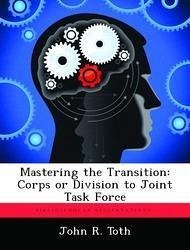This monograph examines the transitions an Army corps or division planning staff must undergo when required to form a Joint Task Force (JTF). These transitions, one organizational and one focused on the planning process, prevent the build-up of operational momentum as forces transition from peacetime to wartime missions. These transitions occur in the initial phases of a deployment and are critical because JTFs attempts to build momentum by planning the deployment of forces and subsequent operations. This monograph examines the joint, Army, and Marine Corps doctrine to determine the organizational requirements, planning responsibilities, and guidelines for the orders production process. The research revealed that the joint and service doctrine fail to achieve simplicity because of differences in organizational structure and a lack clarity in assigning responsibilities for planning. The doctrine also lacks consistency, defining differently the standards used to establish responsibility for plans, future operations and current operations. The monograph uses Operation Restore Hope, as an historical example of the transition from service staff to joint task force. The monograph concludes that the permanent establishment of a planning directorate within the corps and division staffs, modeled around that of a joint staff, would allow the planners to focus on deployment and operations planning and thus build operational momentum.








